Best Product And Machine Design Apps
11 Best Graphic Design Software of 2021 (Free and Paid)
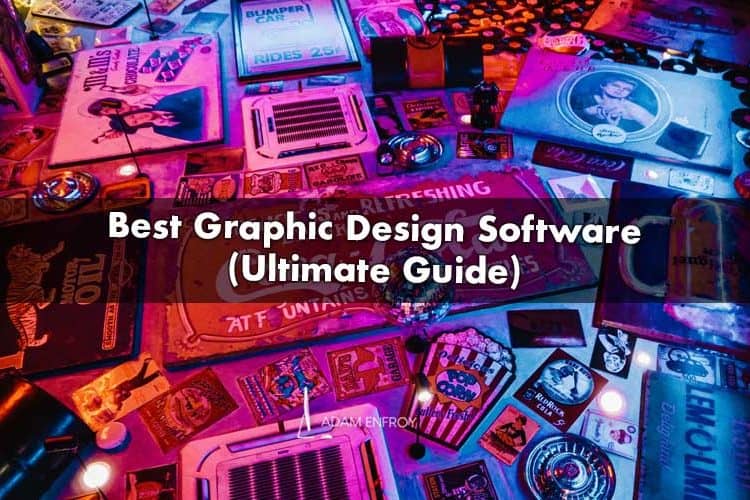
Last Updated on December 1, 2020 by Adam Enfroy
Stunning design that speaks to an audience is paramount for brands of all sizes.
Whether you need this software to help you start a blog like this one or edit product photos for your ecommerce business, selecting the best graphic design software can take your brand identity to the next level.
Considering this trend, Adobe Photoshop has become the reference point of image editing and graphic design software. However, over the years, several other visual design software tools have emerged to cater to different needs and preferences of designers.
A capable graphic design tool not only enhances efficiency, but it also helps in putting stunning creativity into real-world design.
This article will cover the top 11 options ranked in order of quality.
Let's get started.
Disclaimer: Please note, I may receive affiliate compensation for some of the links below at no cost to you if you choose to purchase one of the products. However, these are my top picks for graphic design that I have used and tested this year. You can read my affiliate disclosure in my privacy policy.
What is the Best Graphic Design Software?
1. Adobe Photoshop.
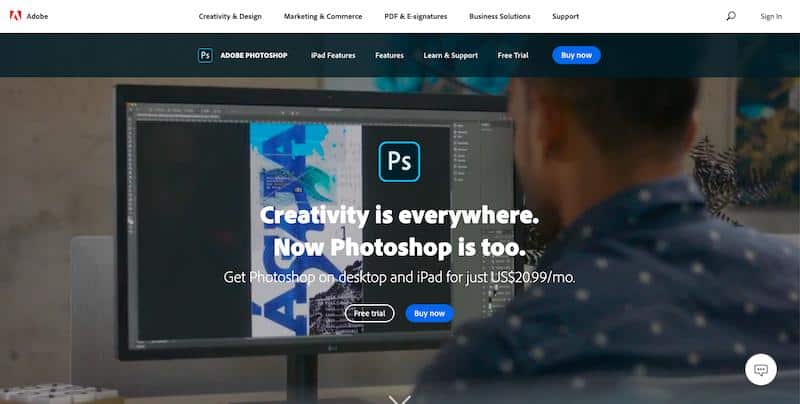
Adobe Photoshop is synonymous with photo editing for graphic designers. It is one of the most popular photo editing software tools in the market in a robust package that offers excellent graphic design capabilities.
Key Features:
- Design Tools: Offers a lot of design tools for both mobile apps and web
- Creative Cloud: Its active synchronization with Adobe Creative Cloud offers a lot of unique features, including Content-Aware Crop, Face-Aware Liquify, Artboards, the Design Space view, synced libraries, a glyph panel, Cloud Documents, touch, and stylus input support, among others.
- User Interface: Adobe is continuously working on delivering a more customizable user interface. It offers several targeted workspace layouts, including Graphic and Web, Motion, 3D, Painting, and Photography, Designer can also create your own custom layout of panels and windows.
- Open-Source GIMP Software: If you don't want to pay a dime, then you can download and install this software for free. Consider installing it on a powerful machine to avoid lag and other performance issues.
Pros:
- It offers a complimentary mobile application
- Its slick user interface offers a lot of assistance for easy use
- Got a rich set of typography and drawing tools
- Comes loaded with 3D design capabilities
- Offers a library and photo management with Adobe Creative Cloud
- Efficient file transfer between different programs
- Multiple design tools come with responsive graphics
- Ability to edit animation and video layers
- Users can define the size of the canvas, create custom brushes, work in 3D, isolate elements from backgrounds, among others.
Cons:
- Adobe now offers Photoshop along with the subscription of Creative Cloud. The recurring payment turns out to be more costly, and people who want to buy software forever don't have the option to buy a perpetual license
- A plethora of features might overwhelm a new user
- Offers lessor support for raster and vector images like SVG files
Pricing Plans:
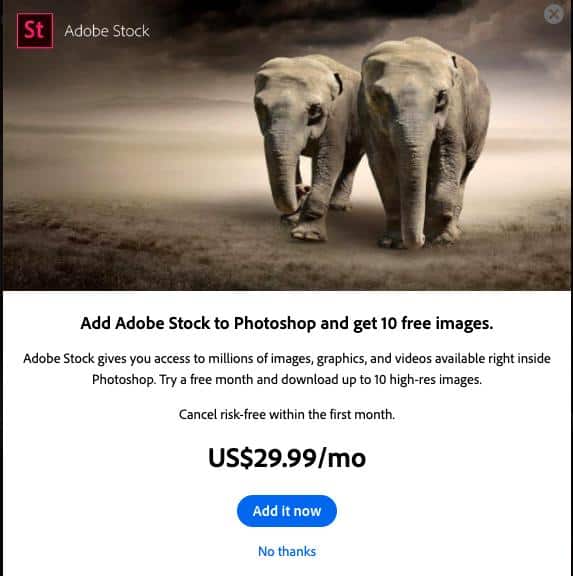
Adobe offers Photoshop at a subscription price of US$33.99 per month per license.
Get started with Adobe Photoshop today.
2. Adobe InDesign.
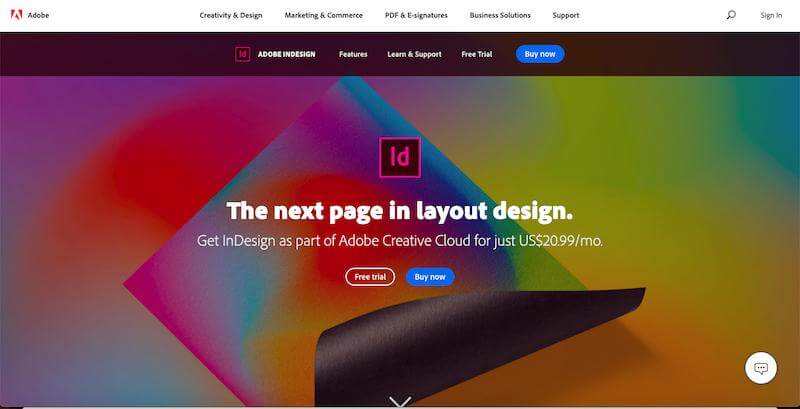
Adobe InDesign is a must-have software tool if you are in the business of publishing. It offers excellent capabilities to design stunning magazines, info sheets, and brochures while easily exporting them to PDF or HTML.
Key Features:
- Easy To Use: Unlike PhotShop, InDesign requires a low learning curve. That means new users can quickly learn how to combine text and graphics to achieve the best results.
- Adjust Layout: The 'Adjust Layout' feature empowers the designer just to change the text of the template, and design gets adjusted automatically, which is great for infographics.
- Sensei Technology: Adobe's AI-powered Sensei technology ensures automatic resizing and arrangement of images.
- Adobe InCopy: Designers can leverage InCopy to work with other members of the team by sharing text, colors, and graphics.
Pros:
- Graphic designers can efficiently combine graphics and texts for easier streamlining and optimizations of files.
- It allows users to add tags to indexes, keywords, anchor text frames, footnotes, table of contents, and captions with hyperlinks.
- It supports HTML exporting that enables web developers to export clean and simple codes during the implementation of the website's layout designs. This works great for WordPress sites.
- It can help you eliminate redundant div tags in HTML files along with insignificant content grouping.
- Has the capability of resizing multiple objects and change the width and height at the same time.
- Designers can leverage its Eyedropper tool to apply position or size instantly to another object within the document.
- It is an industry-standard for desktop publishing.
Cons:
- The less intuitive user interface can make things overwhelming for new users.
- Not positioned for general users. Suitable for enterprise use only.
- Relatively expensive than other similar software available in the market.
- PDF comment integration needs perfection
Pricing Plans:
Adobe offers InDesign at a monthly subscription of $20.99. The full Creative Cloud costs $52.99 per month.
Get started with Adobe InDesign today.
3. CorelDraw Graphics Suite.
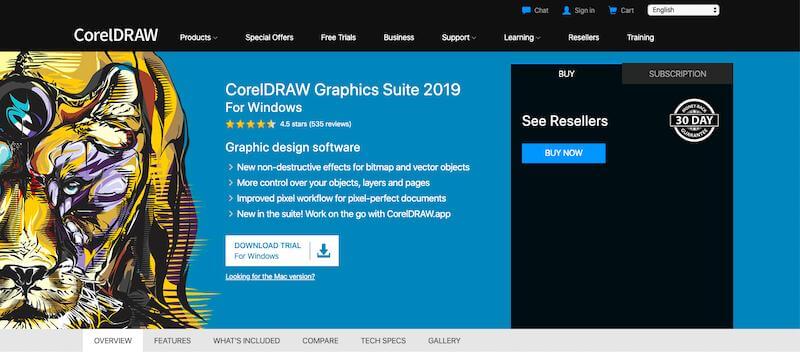
CorelDraw Graphics Suite packs some pro-level features and offers a highly accessible interface that is easy to use. It is a bundle of multiple applications that deliver powerful editing features.
Key Features:
- Content Exchange: It is Corel's online digital library through which registered users can get access to thousands of high-resolution photographs and digital images. It also offers over 2000 vehicle templates, 1000 fonts, 350 professionally designed templates, more than 500 interactive frames, over 600 gradients, vector, and bitmap fills.
- Flexible Payment: Corel offers three payment programs through which users can buy the software along with nominal charges for regular upgrades. It also offers an upgrade program for existing users.
- Customizable UI: You get a customizable UI environment for the desktop, icon sizing, toolboxes, options for how your documents open, and window border color scheme. Users can also visit Corel's developer community website to design macros that suit their workflow.
- New Pointilizer: Corel's new pointilizer offers a lot of variable parameters that are not just limited to regular dots.
Pros:
- It offers app-wide workflow and under-the-hood innovation and performance enhancements to boost productivity
- Works perfectly without any lag with Surface Pen
- Users get the option to choose GPU acceleration over the default CPU while working with system-intensive sophisticated vector graphics
- Smooth transition from desktop to tablet mode to leverage touch features
- It offers better EPS and third-party PDF importing capabilities and leverages with their GPL Ghostscript feature
- It is capable of exporting files in up to 48 file types, including AutoCAD, JPG, PNG, SVG, AutoCAD, JPG, and TIFF. It can also open 35 file types, including EPS, HTML, AutoCAD, PDF, PowerPoint, SVG, and even old FreeHand files
Cons:
- Unlike Adobe, there are no complimentary mobile applications offered by Corel
- Two many payment options might confuse the user
- Not easy to operate for beginners
Pricing Plans::
CorelDraw is available for a 15-day free trial. Its full version is available for $474 with a 30-days money-back guarantee. You can also pay for an annual subscription for $198, or just $16.50/month.
Get started with CorelDraw Graphics Suite.
4. Inkscape.
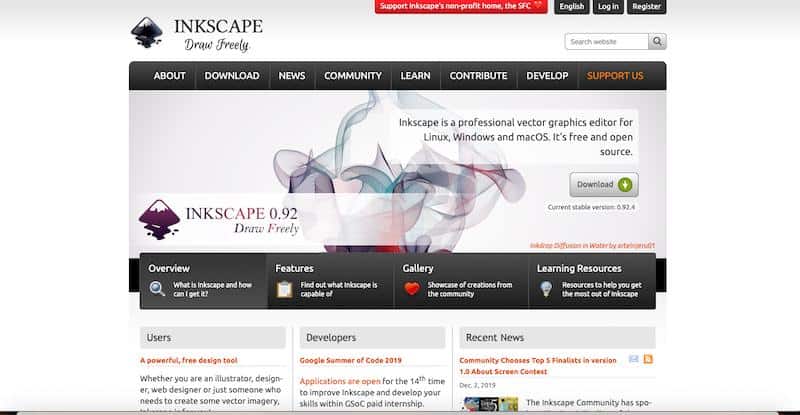
Inkscape is a capable free graphic design software that can help designers create scalable graphic designs that won't stretch or blur during resizing. It's a user-friendly option for hobbyists or beginners interested in vector drawing.
Key Features:
- User Experience: For free vector software, the user experience is quite impressive. Designers who are familiar with Adobe tools can efficiently operate Inkscape.
- Regular Updates: Inscape has a robust community of developers that enables it to provide updates and new features regularly. Its latest update has got mesh gradients, a checkerboard background to view transparency more comfortably, improved spray, and measurement tools.
- Free of Cost: It is one of the most robust and capable alternatives to Adobe Illustrator that is available as a free tool.
- Manual Improvement: Users can leverage the open-source code to change the lines of code and enhance or personalize the software as per the requirement.
Pros:
- Users can easily make individual text lines without frames along with the paragraph type.
- It supports multiple gradients and comes with a separate tool to create complex combinations.
- It comes equipped with Bezier handles to ensure more effortless movement of nodes.
- Inkscape offers several well-designed and full-featured tools to create, edit, and convert vectors.
- It is also capable of downloading or creating ready-made plugins.
- Users can leverage different preset categories of filters to save time and effort.
Cons:
- Inkscapes' streaming text needs to be converted into plain text, for instance, before export.
- The Mac version is not error-free.
- Processing is a bit slower than other graphics software.
- Compatibility with Illustrator is not bulletproof.
Pricing Plans:
Inkscape is an open-source platform that is available for free.
5. Sketch.
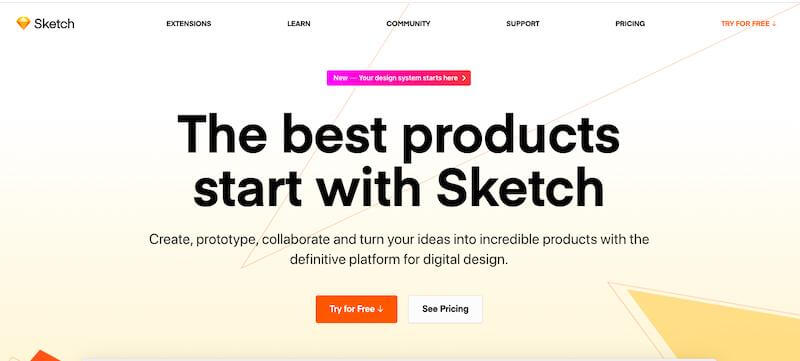
The sketch is a vector-based graphic design tool that is best suited for app, web, and interface design. It is best suited for creating interactive prototypes for UI/UX purposes.
Key Features:
- Low Cost: Sketch offers a yearly subscription that is significantly lower than other subscriptions
- Great For Mobile and Web: It leverages grids, snap to grid functionality, and snap to pixel functionality to avoid half-pixel renders or imperfect alignment. These perfections are critical to ensure perfect responsive design/multiple screen sizes and resolutions.
- Screen Templates: It offers a library of artboard templates for iOS devices and responsive web design layouts. Designers just need to select an artboard and the device.
- Custom Plugins: Designers can easily find custom plugins for specific tasks through robust community support
Pros:
- It allows easy sharing and collaboration through the cloud. Designers can share the entire interface in the cloud through a simple file sharing process
- Users can mirror designs on larger devices for team viewing to identify how the design would exactly look in a particular device
- Users can export any layer or group as a PNG file
- Sketch autosaves all the changes in the design step by step to avoid any loss of design. Significant relief for designers, indeed!
- Users can leverage libraries with standard Android icons, iOS icons, and Mac icons
- It requires a low learning curve
Cons:
- Being a new design tool, it is not entirely polished and requires a lot of enhancement
- It offers limited illustration capabilities that can hamper intricate illustration work
- Screens don't render in high resolution while accessing from the cloud
- Available only for Mac users
- Absence of automatic layout flowing option
Pricing Plans:

The yearly subscription costs $99 per year.
6. Adobe Illustrator.

Adobe Illustrator is more than just a graphic design tool that is perfect for illustrative artwork, page layouts, corporate logos, website mockups, and almost anything else as per the requirement. Moreover, it's an industry benchmark in vector creation tools.
Key Features:
- High-customizability: Adobe Illustrator is highly customizable through multiple preset layouts along with other customizability options. Users can leverage the drag and drop feature to move panels anywhere on the screen.
- In-Panel Editing: Its in-panel editing feature allows designers to edit multiple artboards simultaneously to help designers work with more efficiency.
- Highly Compatible: It is highly compatible with numerous devices that have different configurations from Mac and Windows.
- User Interface: Its user interface is highly accessible and customizable. It offers custom viewing and space-saving features to help you work on any machine.
Pros:
- Instead of stored pixels, it generates graphics based on mathematical equations to ensure crisp and sharp lines that you can print in any dimension
- It creates graphics files in relatively small sizes so that designers can share them easily through a simple email attachment
- You get access to over 90 million images, graphics, templates, and videos from Adobe Stock
- Use Adobe font integration to select thousands of fonts and implement the most suitable font for the project
- Tight integration with other Adobe products
Cons:
- It is costlier in comparison to other vector-based graphic design tools
- So many features can look a bit overwhelming for new users. It requires a steep learning curve to use it efficiently
- It could eat up a lot of space on your machine
Pricing Plans:
Adobe Illustrator offers a monthly subscription of US$9.99 for personal use and US$33.99 for enterprise use.
Get started with Adobe Illustrator today.
7. Affinity Designer.
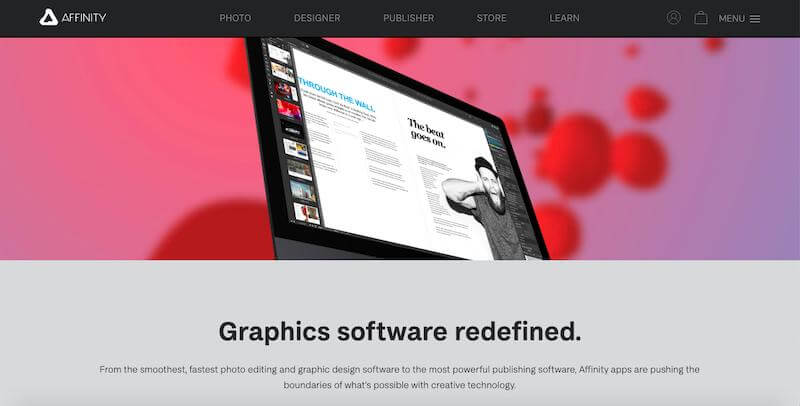
Affinity Designer is a clean, capable, and cheaper alternative to Adobe Illustrator. It offers an excellent budget proposition that is also easier to use and faster than Illustrator.
Key Features:
- Grid Systems: Its versatile grid system enables designers to set up grids while creating isometric video game graphics and icons. This feature helps users in acquiring total control over angles, gutters, spacing, subdivisions to create accurate layouts.
- Snapping Option: It allows designers to lock and position objects and elements depending on multiple things, including grids, alignment guides, shapes, and nodes of other objects.
- Dual Environment: Through Affinity Designer, users can work in both pixel art environments and vector art environment without opening any other application.
- Zoom Feature: Its zoom feature can go as far as 1,000,000 percent enabling designers to design with utmost precision and accuracy.
Pros:
- Designers can leverage dynamic on-screen guides to ensure objects and designs are laid out with accurate measurement and alignment
- Users can create smooth and accurate curves through rope and window stabilizers to create beautiful vector illustrations
- Boolean operation is not only capable of combining shapes, but it is also capable of efficiently moving and editing some parts
- It offers a wide selection of colors to enhance designs.
- Users are also allowed to apply for their work on one project to multiple numbers of artboards
- Its iPad app is as powerful as its desktop application
Cons:
- Doesn't export files in AI
- Absence of natural perspective grid
- Absence of vector eraser in Designer Persona
- Some tools are missing that are available on Illustrator
Pricing Plan:
Designers can buy Affinity Designer software for a one time cost of $49.99.
8. GIMP (GNU Image Manipulation Program).
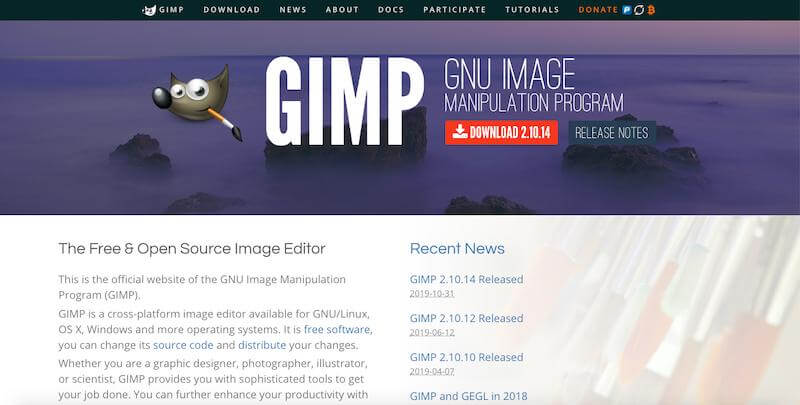
GIMP is much more than just a photo editor that offers a lot of incredible Photoshop features for free. It provides multiple professional-quality functions to fine-tune snaps and create artworks from scratch.
Key Features:
- Flexibility: The photo editing tool's user interface is highly customizable, and the GIMP community has developed several incredible plugins for added features free of cost. People who know coding can customize it to higher levels as per the requirement.
- Regular Updates: Its active community of developers means that it keeps getting regular updates and the addition of new features.
- GEGL Scripts: It is one of the best features of GIMP that makes it an open platform for image processing.
- Compatibility: It is compatible with a plethora of operating systems including macOS, Linux, Windows, Solaris, and BDS
Pros:
- It enables users to sketch the drawing by leveraging tools, including cloning, pencil, and airbrush
- GIMP offers tutorials for every feature to help out the users
- Its Layers feature allows designers to design an image under an existing image
- Clean and easy to use user interface for users who are new to the world of image editing
- It offers the option of working on a modular and single-window interface
- It is very lightweight and uses the computing resources optimally, leading to ensure speedy performance
Cons:
- The user interface is not perfect for Mac users
- Adjustment layers come with a non-destructive way of combining multiple photo manipulations
- The developer community is not significant. As a result, it gets updated at a much slower pace
Pricing Plans:
Since it's an open-source platform, it's an entirely free version of design software.
9. Xara Designer Pro X.
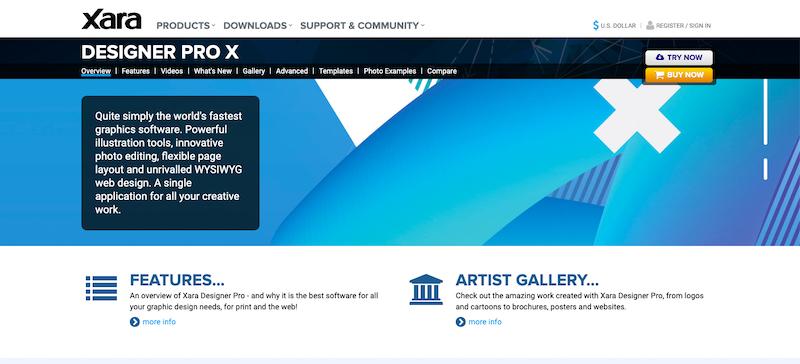
Xara offers advanced features and tools while that provide advanced design elements. The software is used extensively for web and print design solutions to create illustrations, edit photos, and design web pages.
Key Features:
- Direct Action Tools: The 'direct action' tools offer robust features and stable functionalities for general use.
- Drag and Drop Feature: This time saving and intuitive feature allows designers to zoom up to 25,000 percent and leverage direct action tools easily for faster execution of the job. It also allows placing any item on the page through a simple drag and drop.
- Performance: It offers faster performance and gives users an easy way to implement creativity. It also allows users to make numerous modifications through unlimited redo and undo options.
- Super Fast: Xara boasts of one of the fastest and most sophisticated vector rendering engines. This gives it the capability to deliver more complex graphic designs efficiently.
Pros:
- Xara Designer Pro offers substantial editing options, including solid dragging, scaling, and rotating of objects to achieve the best in editing results
- It offers anti-aliasing that helps in improving the quality of on-screen images by softening the edges of objects through blending the edges with the background
- It comes with cloud capabilities to view, edit, and update documents through a web browser on any computer or tablet
- The zoom tool is capable of zooming up to 25,601% to enable designers to take a closer look
- Designer Pro is capable of syncing files with Dropbox and Google Drive
- It offers support to an extensive range of file formats, including bitmap types like JPEG, BMP, GIF, PNG, TIFF, PSD, and allows import of photos such as RAW or JPEG XR
- It also supports importing and exporting Adobe PSD files, including layer support, alpha channel, and 16-bit color and CMYK layer conversion
Cons:
- It is available only on Windows
- Requires a steep learning curve to use all the features efficiently
- The masking feature is cumbersome and difficult to understand
Pricing Plans:
It is available at a yearly subscription of $299.
10. Gravit Designer.
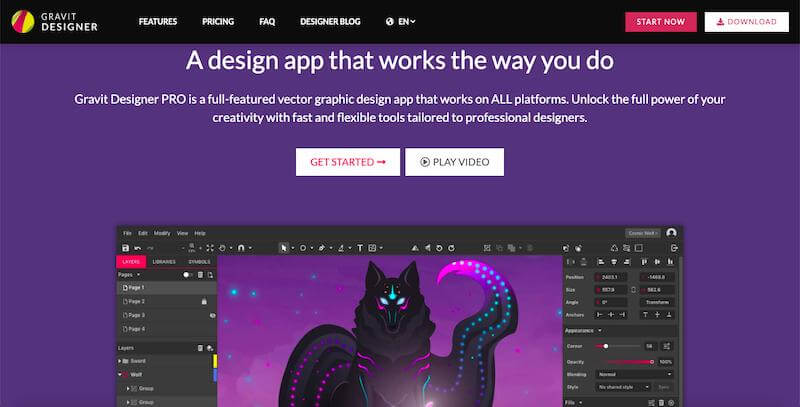
Gravit Designer is an HTML-based graphic design application to deliver high-quality vector graphics. It is one of the most suitable tools for graphic, product, or web designer professionals.
Key Features:
- Gravit Designer Dashboard: The dashboard is easy to navigate and allows to switch between the tabs or switch dark themes instantly easily. Users can also easily set the width and height of the document through the dashboard.
- Pages: Its pages feature a perfect blend of artboards and pages that comes with its canvas settings.
- Tools and Effects: It offers several tools, including the Bezigon tool, Lasso tools, and Pen tool, among others. It also allows adding multiple fills to an element.
- Portability: It offers absolute cross-platform portability for Windows, Mac, Linux, and Chrome OS to enable the designer to work from any machine efficiently.
Pros:
- It offers a modern user interface that is entirely customizable, engaging, and easy to use
- Gravit Designer offers an implicit way to design social media posts for various platforms, including Instagram and Facebook
- It offers natural flexibility through web and desktop versions of the software
- It supports multiple file formats for export as well as import
- It allows editing of scalable vector graphics
- Users get knife and tool support for non-destructive Boolean that makes it a potent tool for user interface design
- Designers can easily open multiple documents and go to the papers on the tab
- Its Pro version offers unlimited cloud storage
Cons:
- There is not a lot of information present about the software from official resources
- A real-time collaboration feature is absent
- Designers can't run prototypes on smartphones to find out how would they look
- Fonts need an active internet connection to work
Pricing Plans:
Gravit Designer comes entirely free of cost with limited features. Gravit Designer Pro is available for $100.
11. Photoscape.
Photoscape offers indispensable features for editing and managing photo archive. It positions itself as a tremendous free graphic design tool for beginners and professionals who don't want to buy expensive subscriptions.
Key Features:
- Editing Tools: Photoscape offers numerous types of image editors, including page, batch editor, editor, viewer, print, combine, print, screen capture, animated GIF, print, combine, and so forth. Its editing toolkit offers a set of distinct and well-labeled features for beginners.
- Multi-lingual: It comes loaded with English and Korean. However, designers can gain access to more than 30 languages through downloadable modules.
- User Interface: It offers a simple and easy to use interface that helps beginners to use the software efficiently.
- Design Module: Its design module and image editing capabilities pack a lot of features, including color adjustments, size, gamma, backlight, resolution, brightness, and so forth. It also comes loaded with text, design, and drawing tools, including effects brush, filters, paintbrush, clone stamp, among others.
Pros:
- The batch editor feature is a boon for designers who edit images regularly. It allows the user to resize, convert, or rename multiple pictures with a single mouse click
- It is capable of opening RAW photos and comes equipped with a converter that allows converting RAW images to JPEG images easily
- It is a cross-platform design app compatible with Mac, Windows, and Linux machines
- It comes with a PhotoScapeX edition for Windows 10 machines that is available free of cost.
- Offers integrated editing and graphic solutions
- It is highly responsive and lightweight that leverages computer hardware smartly
Cons:
- Doesn't provide advanced image editing capabilities like in Photoshop
- Not available on Linux
Pricing Plans:
Photoscape is available free of cost.
Note: other design apps not yet reviewed for this list include Vectr, Microsoft DrawPad, and Pixlr.
What Are the Benefits of Graphic Design Software?
A capable graphic design software tool enables designers to create visually stunning graphics and images.
Here are a few crucial benefits that a capable graphic design software brings to the table:
1. Flexibility and Scalability.
It provides you with the flexibility to create visually stunning images and graphics without actually shooting them. Aside from this, the user can get the file exported into multiple file-formats instantly for easy distribution to other marketing platforms.
2. Cost Efficient.
Apart from paid tools that offer great value for money, there are also free open source graphic design software that designers can leverage to create beautiful designs. It helps in saving a lot of expenses on shooting real objects.
3. Branding.
Graphic design tools help organizations in maintaining their brand positioning by embedding logos and watermarks on marketing collaterals. Users can save templates in the software that can be used every time to maintain consistency of image size and design.
4. Increased Engagement.
High-quality visuals created through graphic design software helps in enhancing brand engagement. It helps in sending the message to the audience more clearly.
How Does Graphic Design Software Work?
There are several graphic design software tools available in the market with their unique set of capabilities. However, they all are built with a single goal of creating stunning artworks. Hence, their basic functionalities are the same.
Here are some of the steps that will help you get the hang of some of the basic functions of a graphic design software work.
1. Create a New Document.
For instance, you are using Adobe Photoshop to create graphics.
You have to launch Photoshop first and click on the "File" option and then "New Document."
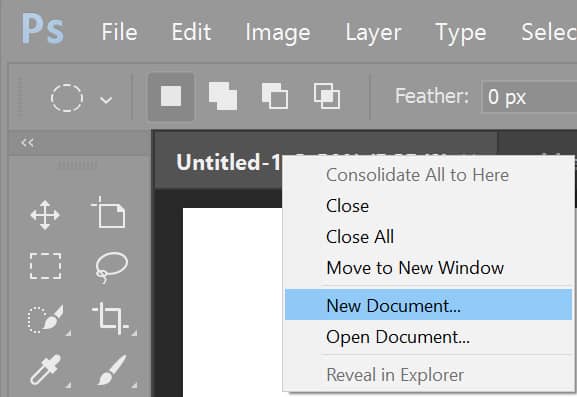
The designer can either select a template or customize the size of the document manually.
2. Enter The Camera Raw-Panel.
Next, you can see what the camera raw-panel actually looks like in Photoshop. Here, you can select the crop tool available in the sidebar to resize your design.
3. Workspace Overview.
This window will display the project you are working on. It may have multiple tabs depending on the number of projects you are working on simultaneously.
Have a look at the workspace from Adobe Photoshop.
4. Learn The Meaning of Basic Tool Icons.
Before you move further, you should know the meaning of the vital tools you'll be using for graphic design.
Here is the list of tool icons that you must know by heart to use any graphic design platform efficiently.
5. Layers, Groups, and Guide.
Playing with layers at the right spot will help in creating visually appealing designs. To create a new layer, just click 'Layer > New > Layer' or tick the box with the folded corner at the bottom right of the window. You can also lock the layers to avoid editing them accidentally.
6. Create a Wallpaper.
Users can leverage a lot of tools to create simple images into stunning visuals that can be used as high-resolution wallpapers.
Executive Summary.
Finding the best graphic design software that meets all your requirements can be overwhelming.
If you want to make the right decision, then it's crucial to ponder over a few essential points, including:
- Budget – Analyze whether you can afford a paid tool or not, or paying the subscription for graphic design software is feasible or not. Decide by weighing the features that you can get from open source tools and what USPs paid tools are offering.
- Features – Go for a quality tool like Adobe Photoshop only if you require intricate vector designs regularly. Otherwise, free software tools like Inkscape are more than enough when it comes to managing basic editing work.
- Collaboration – If your work methodology includes frequent collaboration, then look for a graphic design platform that comes equipped with cloud capabilities for seamless collaboration and sharing of files.
Thinking over these points can help you make the right decision without much confusion.
Further Reading on AdamEnfroy.com: For more software reviews, check out my reviews of the best image editing software, the top choices for video editing software, and my full guide to start a blog for beginners.
Last Updated on December 1, 2020 by Adam Enfroy
Adam Enfroy is a full-time blogger and affiliate marketing expert. Join Adam and 500,000 monthly readers on AdamEnfroy.com to learn how to scale your influence at startup speed. Before starting this blog, Adam managed digital marketing teams for large SaaS startups and reviews the best software to run your online business. He has been featured in over 100 publications, including Forbes, Business Insider, and Entrepreneur. Read more about Adam here.
Best Product And Machine Design Apps
Source: https://www.adamenfroy.com/best-graphic-design-software
Posted by: sampsonnakenceral.blogspot.com

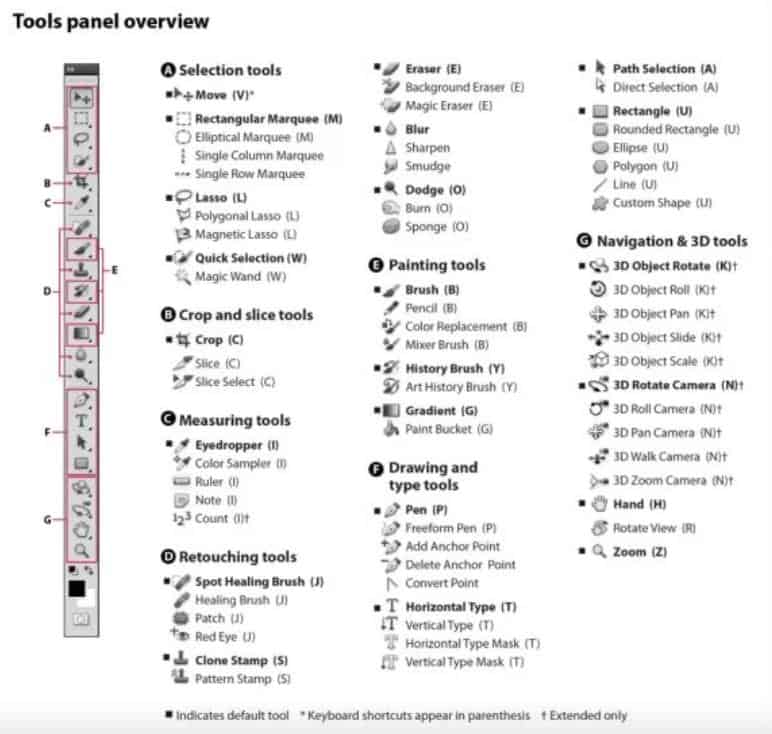
0 Response to "Best Product And Machine Design Apps"
Post a Comment